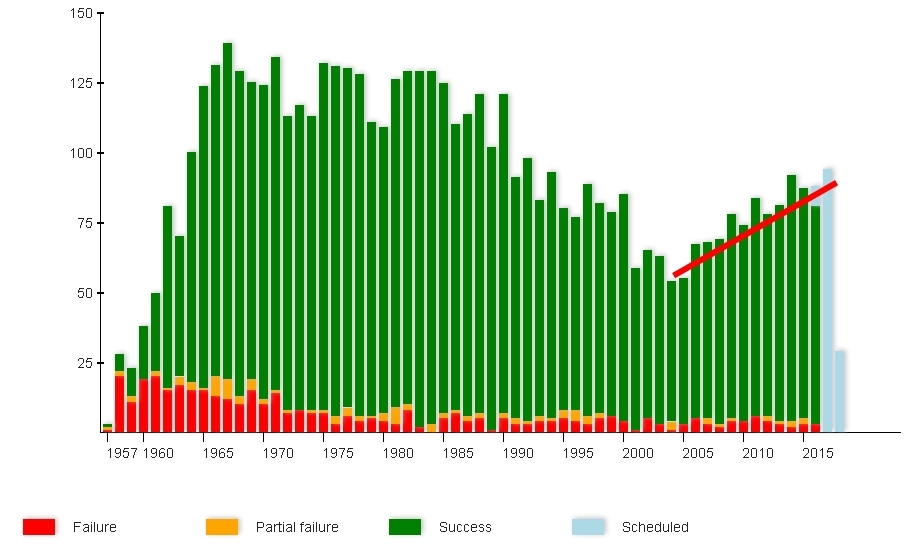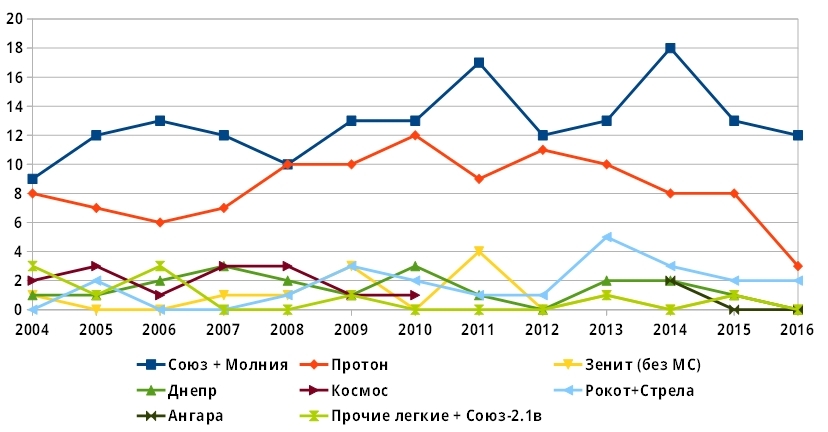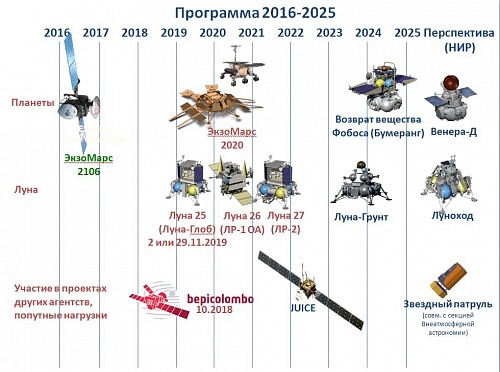Russia is losing ground in the growing global space program. Or not?

The end of the year looks gloomily for the Russian space program. After thirteen years of leadership in the number of starts, we were again overtaken by the United States and, for the first time in history, by China. Until December, there was hope that this year would be the first year since 2003 without accidents with a loss of payload, but it also burned down along with Progress MC-04. Other space news stained the events in even darker tones - the crew of the Russian segment of the ISS will be reduced from three to two people, Progress will also be launched less, the Angara after the test launches did not start flying often, and bad rumors came from the Khrunichev center. Not a single Russian interplanetary station started up after the failure of Phobos-Grunt in 2011, and since 2013, the new module Science has not been able to go to the ISS. We are all bad, and you can bury the Russian space program? Or is it not? Let's try to figure it out.
Starts
On December 19, 2016, Russia launched 17 launch vehicles, of which one crashed. Two more rockets were acquired by the European Space Agency and launched from the Kourou cosmodrome, but even if they are added to our piggy bank, Russia will still be in third place. At best, we are launching another Proton with the EchoStar telecommunications satellite in late January, while the US has already completed 22 launches (the Falcon 9 crash in September in preparation for the burn was counted as an unsuccessful launch), and China - 20. This news It is many times sadder if you look at the big picture, because the number of launches throughout the world has continuously increased since 2004.

')
If you look at the same graph by country, you can see the trends in recent years.

Since the beginning of the tenth century, China has shown a rapid growth in the number of launches. This is not surprising for the economy, which in 2010 became the second in nominal GDP and in 2014, the first in GDP in PPP. China's space program is extensive and diverse. In addition to communications satellites and remote sensing of the Earth (from meteorology to exploration), China is developing its Beidou navigation system, which will become global by 2020. After a noticeable break in 2016, manned launches resumed, a new Tyangun-2 orbital station was launched into orbit, and Tianlian retransmitting satellites for a manned program similar to those of the American TDRS and the Russian Beams were launched. A scientific program is developing from unmanned lunar vehicles to the world's first quantum communication satellite in low earth orbit. At the same time, the new campaign “Great March” -5,6,7 are being developed, which, if the five-year plan of 2016-2021 is fulfilled, will be launched 30 pieces a year. In this case, China will compete for first place in the number of starts.
The launch schedule for the United States does not show serious growth, fluctuating in the range of 12-24 launches, but the composition of the launch vehicles used has changed a lot. Having started with several launches a year in the interests of NASA, SpaceX has concluded a large number of commercial contracts, set a very ambitious schedule, and if not for the crashes in 2015 and 2016, it could reach a level more than a dozen launches per year (in 2016 their there will be nine, according to the latest news, December launches moved in January). 24 launches of the Falcon 9 and two of the Falcon Heavy are scheduled for 2017, and the main intrigue is how many percent this plan will be executed - SpaceX is known for its postponement.
The European Space Agency, located in fourth place, has also increased the intensity of launches, albeit only slightly. The fact is that it has now begun the active deployment phase of its Galileo navigation system, and, until a constellation of three dozen satellites is deployed, ESA will launch more launch vehicles than usual.
Fifth place in India shows a serious growth in their space industry. For the first time, India reached the level of more than five launches per year, of which three went to complete the deployment of the local navigation system IRNSS.
And what about Russia? Our third place is the result of one sad fact, one neutral, and, paradoxically, two good ones. Consider the distribution of launches on carriers.

The first, sad fact is the drop in the number of commercial orders for launching satellites into geostationary orbit on Proton. There are several factors mixed here. ILS, which sells Proton launches on the world market, did not fall under direct sanctions, but for political reasons its attractiveness decreased. Further, since 2010, one accident per year has occurred at the Proton. In 2016, the emergency situation was also , but did not lead to the loss of the payload. Such statistics and directly repels potential customers, and increases the cost of insurance, making the launch more expensive. And, finally, the cost of launching the Proton has ceased to be much cheaper than its competitors. The exact amounts are unknown, but if you follow the news, customers with their satellites can either leave the Proton on the Falcon 9 or Ariane 5, or go in the opposite direction, if, for example, SpaceX starts to delay launches too much. But there is still hope that this failure will be temporary - in the September meeting with Vladimir Putin, the head of Roscosmos Igor Komarov said that contracts were signed for 10 Proton launches in 2018-2019.
The second fact, neutral, is to change one launch vehicle to another. This is a normal process, when some launch vehicles are replaced with new ones. In the zero years ended the career of "Cosmos" and "Cyclones". Now the conversion of the Dnipro program is coming to an end, when combat intercontinental rockets were converted into space rockets and satellites launched. All these are light rockets, which made a small but noticeable contribution to the total number of launches. Now, their payloads will be transferred to the new Soyuz-2.1v and Angara-1.2 light missiles, or they will be launched in groups or by passing loads on more payload ones, Soyuz.
The third fact, positive, is that the formation of large satellite constellations has ended in Russia. The GLONASS system is fully deployed and needs new launches only to support the group, for example, this year GLONASS launched only two pieces. There will be new constellations of satellites - there will be more launches. For example, for 2017 it is planned to put into orbit two satellites of the new connected system "Blagovest", and another one in 2018 or 2019.
The fourth fact is very positive - our satellites began to work in space longer. Previously, the Strela / Spring / Messenger communication satellites lived only one year, and they had to be launched literally in batches. But in 2016 there was not a single launch - the group was formed in an excess composition, and so far there is no need to replenish it. Until the middle of the tenth years, we had reconnaissance satellites with film cameras flying. To return the film to Earth, special small capsules were used, their number was limited, and the satellite could not work constructively for more than a few months. And now, “Persons”, “Leopards” and civil “Resources” have been quietly working for years, sending digital photos over the radio, and do not require constant replacement.
Crash
In the most general case, you can construct a graph of the relative accident rate by country, dividing the amount of emergency starts (partial success, we will assume half of the accident) by the number of starts in the country. The result is curious.

First of all, it is necessary to note the almost zero accident rate of the European Space Agency. The only spike in the graph in 2014 is associated with the withdrawal of Galileo communication satellites into an off-design orbit by the Russian Fregat upper stage, and this is partly a success - the satellites were eventually transferred to working orbits, and they function successfully. As for the USA, Russia and China, their accident rate is at a comparable level and, apart from some years, does not exceed 10%. But the devil, as usual, is hiding in the details. On this graph, we mixed together all launches of all launch vehicles, including, for example, the Falcon 1 or the first and most likely unsuccessful launch of the SPARK that had not yet started to be used. In our case, in addition to the completely excusable failures of the Start or Wave in zero, about which everyone has already forgotten, the Soyuz and Proton accidents continue to suffer, which over the decades of operation should have been adjusted along and across, even taking into account the constant upgrades. And if we look at the causes of accidents, they will be very different. That will be wrong in the documentation, they will flood the fuel by the measure, and in the new block, by this measure, two tons more fuel is obtained. That, on the contrary , each node works within the boundaries of permissible parameters, and all of them together go beyond the boundaries. I had to install additional sensors and lose another rocket, until the reason was finally established. There is a feeling of “trishkin kaftan” - the problem emerges in one place, it is patched, meanwhile in another place control weakens, and a new problem arises there. Given the complexity of space technology, this is not surprising - for trouble-free operation, it is necessary to maintain high quality everywhere, and our space program copes with this with varying success. Cautious optimism suggests that recently the causes of accidents have proven difficult - simple oversights seem to have learned to catch.
As for the recent accident of the Progress MS-04, the emergency commission is still working. According to unconfirmed rumors from the Astronautics News magazine forum, telemetry did not disappear suddenly, Progress for some unknown reason managed to secede, and only then the third stage, with the engine still running, caught up with him and hit him. The accident scenario does not fall on the normal operation of the systems, so the reason seems to be quite complex. It is of particular concern that in such a scenario the accident becomes similar to the accident of Progress M-27M in 2015. In this case, the cause was called the “frequency-dynamic characteristics of the bundle” of Progress and the third stage, and now there are some doubts about its correctness. definitions.
Crews ISS
At the beginning of autumn there was news that the Russian crew of the ISS would be reduced from three to two. The reason is simple - the money allocated to the federal space program is being reduced, one cargo Progress had to be removed a year, and without it there would not be enough supplies for three cosmonauts. The hardest blow this decision inflicted on the Russian cosmonaut. Already planned crews (and joint workouts begin years before the flight) were shaken up. But the worst thing is that if you had to wait about 9-10 years before your turn to fly, now this period has increased. It is reasonable that, against such a background, the selection was transferred to astronauts, which was expected in 2016 - newcomers would have to wait their turn for an unreasonably long time.
But every cloud has a silver lining. The existing scheme, when astronauts and astronauts started and landed on the same "Union", occupying all three places, made space tourism impossible. With an abbreviated crew, one place can be sold somewhere for $ 50 million, bring a tourist in one Soyuz with a new crew and return to Earth in another Soyuz with a crew that has finished the watch in a few days. A similar scheme was successfully used in zero years. In the spring of 2017, a cargo container will fly in the third seat, because it takes time to switch to the new scheme, and in August 2017, the first space tourist can fly after a long break.
"Angara"
In 2014, the future of Russian launch vehicles looked clear. The old and poisonous "Dnieper", "Rokoty" and "Protons" will be removed from the scene, and their place will be taken by a new and environmentally friendly "Angara". Its universal rocket modules will bake like cakes, quickly and cheaply, and it will often start in different configurations. But two years later, the situation looks much more complicated. "Proton" desperately refuses to retire, on the contrary, it will have lightweight versions. “Angara” after its debut flights in 2014 has not yet begun to fly regularly, and its competitors are already beginning to appear in the form of the Phoenix / Sunkar project.
In 2017, one launch of the Angara is planned in the light version. In 2018 and 2019, there are plans to launch Gonets satellites on the light Angara. Geostationary AngoSat, which was planned to be launched on a heavy Angara, was transferred to Zenit Sea Launch according to the latest news and will be launched on July 15, 2017. These rates are quite alarming. "Angara" can not be the Russian "Delta-IV" - a heavy and expensive rocket for government launches, for this is trivial no money. And the situation in which it will fly only in the light version will in fact be a failure of an interesting and promising project from an engineering point of view. At the end of 2016, the future of the "Angara" looks far from cloudless, but in the history of astronautics there have been various quirks, and it is too early to write it off completely.
MLM "Science"
Another long and sad story is the multifunctional laboratory module "Science", which was originally supposed to start in 2013, moving down already in 2018. In the first half of 2013, in preparation for the launch, contamination was detected in the pipelines of the module, and MLM had to be returned for revision , on which he is still. Since the money for the creation of the module has long been over, work on it is taken into account in the budget as an upgrade. According to the plan, the ISS will serve until 2024, therefore, if Science is launched in 2018, the module will have time to work in the station for only six years, which is not enough by today's standards. In addition, against the background of a reduction in the budget for the space program, work on the Science can be stopped for a while, which will move the deadlines to the right. I would not be surprised if, as a result, “Science” will become the basic module of the lunar orbital station in the mid-to-late 2020s, the plans for the creation of which are now being discussed.
Situation at the Khrunichev Center
At the beginning of November, a story by an employee of the Khrunichev Center about poor management and potentially corrupt practices appeared on pikabu. At the end of November, there was information that the Investigative Committee of the Russian Federation initiated a case on the embezzlement of 300 million rubles in TsiH. And as an insider go here are anonymous poems on a branch.

The problems of TsiKh are also connected with other sad facts - the Khrunichev Center makes Proton and Angara, and it was from him that the Science module with polluted pipelines came to RSC Energia. It seems that in recent years the leadership in TsIH lacks competence and integrity. One can only hope that the joint work of the Investigative Committee and the Roscosmos transformed into a state corporation will be able to bring some order to this enterprise.
Scientific devices
The problem continues to be the fact that Russia has failed to launch any of its interplanetary stations. Mars-96 in 1996 and Phobos-Grunt in 2011 did not fly farther than Earth's orbit. Unfortunately, at least another three years, this situation will remain unchanged. But at the same time, it cannot be said that Russia does not take any part in the study of the Solar system by spacecraft. The fact is that Russian scientific instruments are on interplanetary spacecraft of other countries. The most famous of these are neutron detectors , which search for hydrogen in the form of water ice on other celestial bodies. Since 2001, the Russian HEND detector has been spinning around Mars on the Mars Odyssey apparatus. Water ice in the polar regions of the moon was found by the LEND detector, which has been operating on the LRO probe, which has been operating since 2009. On the famous rover Curiosity is the Russian device DAN. And finally, our TGO Neutron Detector and ACS Spectrometer are located on the TGO apparatus that arrived in Mars in October 2016.
In addition to installing their instruments on foreign spacecraft, Russia is cooperating with other space agencies. In 2003, the Mars Express probe, which is still working successfully, went to Mars on a Russian Soyuz rocket. Here cooperation was minimal - ESA simply bought launch services. On the other hand, the Exomarss mission, which started in 2016, is already being conducted in closer cooperation - Russia provides launch services, manufactures some scientific instruments, will make a landing platform for the rover 2020, and even receive information through its ground-based antenna systems.
As for the Russian interplanetary stations, the most relevant plan was probably shown at the Meeting of the RAS Council on Space on November 17, 2016, in the section “Planets and Small Bodies of the Solar System”.

Present state of affairs
The publication is large, and the topic is quite holivar. Some readers prefer to immediately start the same type of moaning in the comments. Therefore, I will post here a small "test for lice." Those who write a comment with a famous photo of Gagarin's bust and the caption “Forgive me, Yura, we are all in the project ...” did not read the material. Because Russia:
- In 2016, it ranks third after the United States and China in the number of space launches.
- It occupies the third place in the number of active spacecraft in Earth orbit (after the United States and China). If we describe the satellite constellation of Russia in one word, it will be “pragmatism” - we have coherent, navigation, meteorological, military, and remote sensing satellites in different ranges.
- Operates the second largest segment of the International Space Station (after the US)
- Together with China, at least until 2018, it will be one of two countries capable of launching a human into orbit. In 2018, the first flights of American manned ships are expected.
- A few more years together with the USA will be one of the two countries with a global navigation system. Global navigation systems are also being developed by China and ESA.
- It has two cosmodromes on its territory (Plesetsk, Vostochny), rents a third (Baikonur) and sells its missiles for a fourth (Kuru).
- It has launch vehicles ranging from light to heavy, capable of outputting satellites on its own and making money on launch services.
Against this background, to say that everything is completely bad, and to bury our astronautics, frankly, is incorrect.
Bright future
I want to end on a positive note, so I made a small list of potentially breakthrough Russian technologies. All of them, at best, are in the experimental stage, they can be developed for a long time and, since we don’t know the future, they may turn out to be dead-end technologies. But for now they look very promising.

Transport and energy module or, in simple terms, a nuclear reactor with electric propulsion. A nuclear reactor gives a unique energy density, and electrojet engines provide an unsurpassed specific impulse, allowing you to fly much more efficiently than chemical engines. It has been developed for a long time, recently there were rumors about the closure of the project, but according to the latest news , work continues, and, if not so soon as we would like, a unique device may be in orbit.
Detonation engine . All existing rocket engines fuel burns. But if a supersonic shock wave propagates in the combustion chamber, the fuel will explode and detonate. Such an engine will be called detonation. Theoretically, a fuel explosion should provide a higher specific impulse than burning, and the detonation engine will give a higher speed increment for the same amount of spent fuel. Exact numbers have not yet been named, but there are already video tests on the network.

Methane engines . The trend of the beginning of the 21st century is the reuse of launch vehicles. No one yet knows what will come of this , but, just in case, it is better to be prepared for a possible technological revolution. And methane engines, being simpler than hydrogen and not requiring large tanks for fuel (hydrogen has a low density, so it takes a lot of volume even in liquid form), may well become mainstream rocket production. Russia has such engines, in the photo above are tests of the demonstrator RD0110MD.

Hypersonic engines . So far, they are being tested by the military in secret, and in the photo above is the old project “Cold” of the 90s. But, judging by the news, the tests are successful, and in a couple of decades hypersonic engines may well come into the civilian cosmonautics. And there they would be very useful, allowing you to make the "Spiral" of the 21st century, as it was conceived in the twentieth, or, for example, to assemble a project from specialized stages .
Conclusion
In my opinion, your country will not have problems in the space program in only one case - if you play “Civilization” at the easiest level of complexity. Already on average complexity you will not have enough resources for all desires, what can we say about the real world. Russian cosmonautics has enough problems, in some places it has lost ground, and one can say that it is in crisis. But to bury it is absolutely wrong, and our cosmonautics may well get out of this crisis more beautiful than it was.
Source: https://habr.com/ru/post/400017/
All Articles